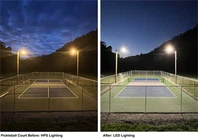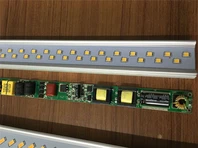How to Light an Led Bulb with a Battery
A fun exercise you can perform to learn about electrical circuits and direct current (DC) electricity is lighting up an LED light bulb with a battery. Since regular batteries cannot produce enough voltage to operate a powerful light bulb, it is not a practical method to power an actual light source. However, you can have some joy building various circuits between a battery and an LED bulb using just a few simple materials. Once you've mastered creating a basic circuit, you can alter it by adding switches or extra batteries. To show how acidity and metal interact to produce electricity, try building a natural battery out of lemons and scrap metal!
Using a Home Battery to Power a Bulb
Obtain a tiny, 3V or lower, low-voltage LED bulb. Ordinarily, 120V or more is needed to operate regular-sized light bulbs, such as those found in lamps or overhead fixtures. These larger kinds of bulbs cannot be illuminated by a standard household battery.
For instance, you could use a tiny LED bulb from a torch.
It would be necessary to connect several 12V or higher batteries in series to power a higher voltage light bulb, which is unsafe to do for this exercise because you risk receiving an electrical shock.
For LED bulbs, follow the steps below.
Remember that they are polarised if you use a normal LED and follow those instructions.
Always attach the battery's shortest leg to the negative terminal and the longest leg to the positive terminal. Otherwise, the LED might stop working or get harmed.
Use batteries with a power no higher than 3V to avoid having your LED blow up.
Connect the battery's positive terminal to the bottom of the lightbulb using copper electrical cable. Place your LED bulb, a household battery, and a flat work area there. Put a copper electrical line up against the terminal of one battery, and secure it there with electrical tape. Attach the wire's other end with tape to the LED bulb's base.
Any typical household cell will work, including the 1.5V AA, AAA, C, or D batteries.
If you do not have electrical tape to connect the wires temporarily, you could simply hold them in position. Being electrocuted by such a low power is not a possibility.
Tip: You can solder the wire into position if you want to create a more durable connection.
Connect a cable with tape to the battery's other terminal and place it next to the bulb's side. Put a copper electrical wire's one end up against the battery's second contact, and secure it there with electrical tape. If you want to keep the LED light lit, position the other end against the side of the bulb's base and tape it in place.
The light bulb turns on as a result of a full electrical circuit being created between the positive and negative battery terminals and the two wires found inside the light bulb's base.
By touching the light bulb straight to 1 of the battery terminals for 1 of the connections, you can also attempt this experiment with just 1 wire. For instance, you can light a lamp by touching the side of the base to the other battery terminal if you tape an electrical wire between the bottom of the bulb and one of the terminals.
Variations Added to the Experiment
Toggle switches can be added to your wiring to turn the light on and off. Purchase a small toggle switch with electrical cable connections. One of the copper electrical lines that is attached to the battery should have its end wrapped around the power terminal of the toggle switch. Connect the toggle switch's accessory side to the LED bulb using an additional electrical cable.
An electrical switch known as a toggle switch has a knob that can be flipped back and forth to turn on and off a device. Two wires in the electrical circuit are either connected or blocked to make it function.
To make the project more portable, get a battery holder. Buy a battery receptacle that fits the size of the batteries you plan to use in your circuit. The 2 electrical cables that emerge from the holder should be connected to the side and bottom of the lightbulb after the battery has been placed inside the holder.
Since most battery holders have an ON/OFF switch, you can simply toggle the light bulb on and off while carrying around your experiment.
Consider purchasing a tiny bulb holder to make your project even more portable and stylish!
Try adding more batteries and lights. Connect numerous batteries by taping copper electrical wires between one battery's positive terminal and the next battery in the series' negative terminal. Try varying the number of cells in the circuit to see how the brightness of a single light bulb changes, or try adding more lights by attaching them to any battery in the circuit.
Which batteries you attach additional light bulbs to won't matter if you decide to expand the circuit. The batteries effectively operate as a single, more potent battery because they are wired together.
Remember that you risk blowing out the light bulb if you use too many batteries to power a single lamp. One 3V light bulb might burn out if six 1.5V household batteries are used to power it. You won't be in any peril, but the light bulb will no longer function.
How to Make a Lemon Battery
Use a low-voltage LED light with a 3V or lower output and four lemons or more. Your lemon battery will be more effective the more lemons you use. Use a tiny LED light that is less than 3V if you want the lemons to be able to charge it.
For this experiment, a tiny diode, such as one from a string of Christmas lights, or an LED bulb from a small flashlight work well.
Similar to how battery acid does inside regular batteries, the lemon juice in the lemons offers an acidic solution for the creation of a battery.
You can test this theory with other acidic fruits or even potatoes after you attempt it with lemons.
Between your palm and a hard surface, squeeze the lemons. Put a lemon on a table or other sturdy surface and press down with the back of your hand. To release the juices inside, roll it back and forth on the table while providing pressure. For each lemon you use, follow these steps.
By doing this, you can be confident that the metals you put inside the lemons will come into contact with as much of the juice's acid as possible.
Each lemon should have a galvanised nail and a tiny piece of copper wire inserted into it. Each lemon should have a straight piece of copper wire inserted into one end and a galvanised nail inserted into the opposite end, with the wire and nail extending to approximately the centre of the lemon. Leave enough of each component protruding so that electrical wires can be wrapped around them.
The length of the wire and nails is unimportant as long as you can pierce the lemons with them and still have enough sticking out for connecting electrical lines.
By weaving wires between the copper and nails, you can chain the lemons together. One lemon's galvanised nail should be closely encircled by one end of a copper electrical wire. Wrap the copper wire in another lemon with the other end firmly wound around it. To form a chain out of all the oranges, repeat this action.
A free bit of copper should be present on the first lemon in the chain, and a free nail should be present on the last lemon.
To create these connections, you could also use electrical wires and alligator clips.
Connect the first lemon's loose copper to the LED bulb's base. The copper component in the lemon-shaped piece at the front of the chain is wrapped with one end of a copper electrical cable. Connect the wire's opposite end to the bulb's base.
If you want to keep the wire in position, you could use a small piece of electrical tape to tape it to the bottom.
Wrap this wire around the longest of the two legs if your LED diode has two legs rather than a bottom.
Place a copper cable between the side of the bulb and the last lemon's free nail. Copper electrical wire should be coiled around the lemon's galvanised nail at the chain's rear. To turn on the lamp, touch the other end of the wire to its side.
Wrap this wire around the shorter of the two legs if the LED diode you're using for this exercise has two legs rather than just one that you can touch the wire to.
The light will probably be quite dim because lemon batteries don't generate a lot of power. To see how much brighter you can make the lamp light up, try using more lemons to create a more potent battery.
Led Bulb With Battery Backup
Feature
● Installation
Twist your bulb in and turn on/off as normal, including unplugging from power source.
● Smart circuit rescue
When a power outage is detected, Everbright uses its internal battery for backup power.
● Rechargeable battery
It provides up to 3.5 hours of light (60% brightness) & takes 6 hours to recharge.
Specification
|
Power Consumption: |
9W |
| Power Factor: | 0.9 |
| Operating Temperature: | 14 to 104ºF (-10 to 40ºC) |
|
Colour Temperature: |
3000K |
|
Brightness: |
500 lumens (40W equivalent) |
|
Voltage: |
100-120V AC, 50/60Hz |
| Beam Angle: | 125º |
| Lifetime: | 25000 hrs |





